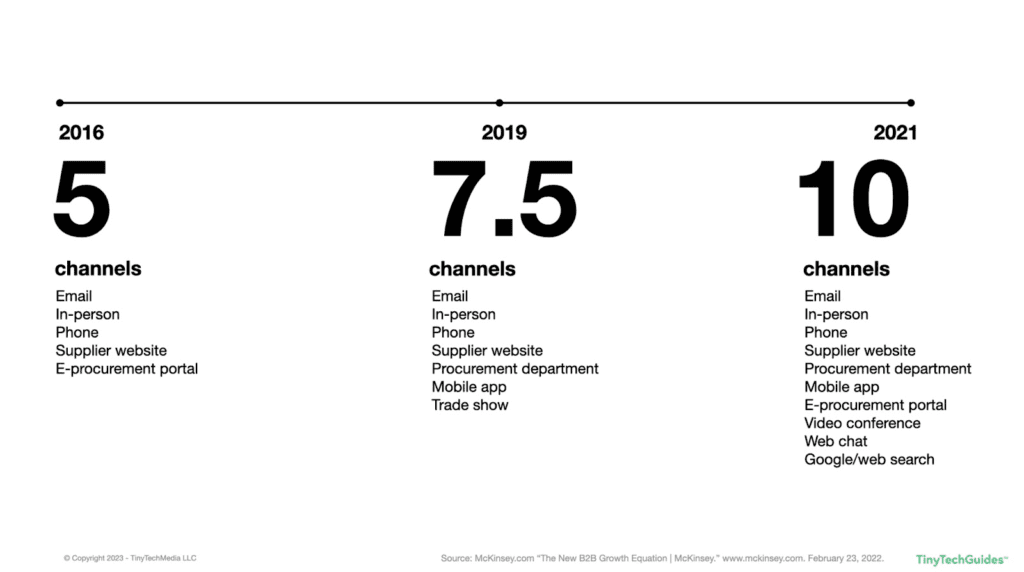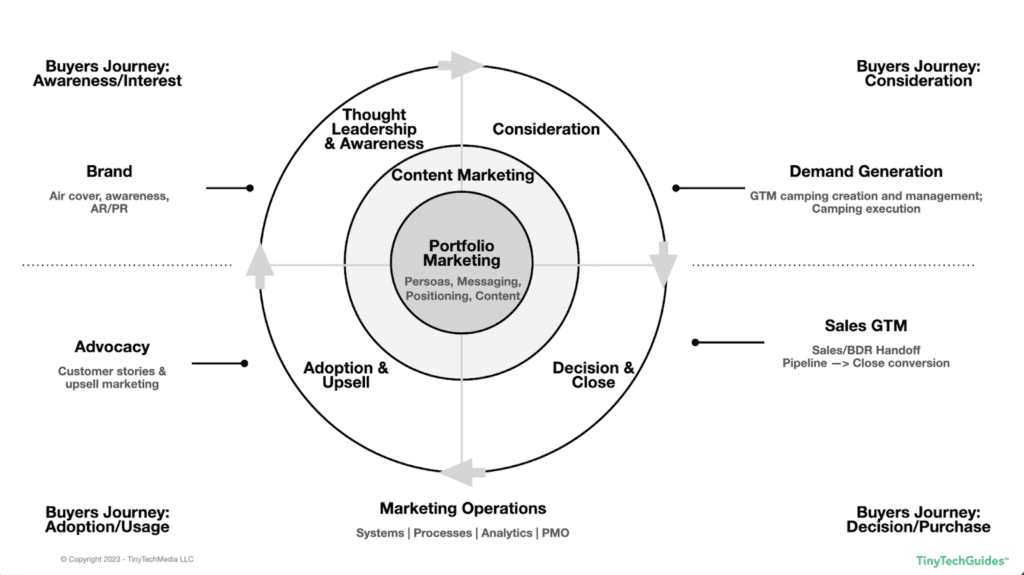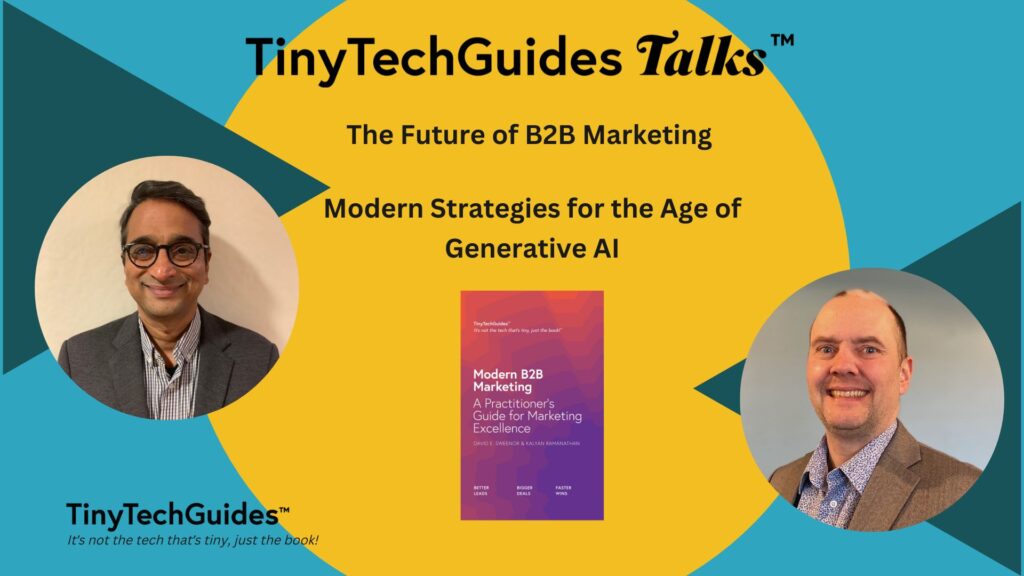An Integrated Approach for GTM Success


When Kalyan and I went to business school, the 4Ps of marketing—product, place, price, and promotion were the cornerstone of the curriculum. Although this was a useful framework at the time, it was primarily centered around the company that was producing the product or service.
- Product: Physical goods or services (lots of discussion on the product life cycle).
- Place: How to distribute and where customers can buy it.
- Price: How much someone is willing to pay.
- Promotion: When to offer a sale or discount.
Fundamentally, this 4Ps model assumed that if a business could master the 4Ps, customers would naturally be inclined to buy their product or service. Customer centricity was not really part of the equation—it was generally assumed that the product or service took customers’ needs into account and switching costs were high so customers didn’t really have decent alternatives to choose from.
As the internet became pervasive and the digital economy grew, the 4Ps framework also evolved. The digital economy is now more customer-centric than ever. In business-to-business (B2B) marketing, we have moved from advertising, press releases, inbound sales, and promotions to more customer-centric and experiential marketing. Organizations now need to deeply understand what B2B buying committees want across an ever increasing number of channels. With the rise of platforms, partners, and hyperscalers like Microsoft, AWS, and Google, the game has changed. As marketers, we now not only need to intimately understand everything about our prospective customers, but we also need to clearly articulate how our offering fits into the broader ecosystem.
In fact, you can see how the number of channels grew over time.


Number of Channels from 2016 – 2021. Source: McKinsey.com
There are untold resources on marketing and its different functions—brand marketing, content marketing, social media marketing, and more. However, throughout our combined fifty-plus years spanning twelve different B2B software companies in the field, Kalyan Ramanathan and I have failed to find an informative, yet digestible book for business-to-business (B2B) marketing grounded in day-to-day realities. We wanted to write a book that explains how the various marketing functions fit together. We wanted to provide practice advice, explanations, tips and best practices on how B2B marketing actually works in real life. We are extremely proud and excited to announce that we have published a TinyTechGuide to address this content dearth.
Modern B2B Marketing: A Practitioner’s Guide for Marketing Excellence is designed for anyone who leads, works, or engages with marketing. It’s for business leaders and chief marketing officers (CMOs) who want to learn how to sustain a high-performance marketing organization; for product managers and sales professionals who often work with marketing but don’t understand how it all fits together; and for marketers early in their careers who want to understand how B2B software marketing works outside of a classroom setting. This book is not about marketing technology or a rehash of the Pragmatic Marketing Framework. It is a practitioner’s guidebook for effective, modern B2B marketing.
For those who work in B2B marketing today, we are all keenly aware that customer centricity is the key to unlocking value. Modern B2B Marketing is built around the customer and provides an integrated framework and approach to marketing, including downloadable templates that will help you improve performance in portfolio and product marketing, content marketing, demand generation, marketing operations, customer advocacy, and more. Kalyan and I developed the Modern B2B Marketing Framework.


Modern B2B Marketing Framework
From a high level, this book walks around this framework. We have organized the book into nine chapters, each of which examines a specific marketing function and how they interrelate to one another.
- Introduction
- Describes the differences between B2C and B2B marketing, the evolution of the modern marketing mix, and introduces the B2B modern marketing framework.
- Portfolio Marketing
- Examines how product, solution, industry, and ecosystem marketing act as a “glue function” to coordinate GTM activities across product management, sales, presales, marketing, partner ecosystems as well as customer success.
- This chapter provides positioning and messaging templates, product launch templates, the role of portfolio marketing leadership, organizational structures, activities, and product launch activities.
- We also provide typical metrics for portfolio marketing functions and a quarterly business review (QBR) template.
- Brand Marketing and Corporate Marketing
- Illustrates how brand and corporate marketing can help drive demand for your products and services.
- This chapter details the importance of brand., the sources of value for B2B buyers, and the relationship between brand and corporate marketing.
- Communications Team
- Emphasizes the importance of a strong communication team for internal and external comms.
- We describe what external comms, internal comms, customer comms, analyst relations (AR) and social media teams do and their day-to-day activities.
- Content, Thought Leadership, Influencers, and Communities
- Discusses what makes good content, the role of artificial intelligence (AI) and the future of marketing with technologies like ChatGPT
- Describes how to build an effective content marketing strategy, and provides a content map template.
- Demand Generation
- Highlights how demand gen creates buyer interest by creating long-term engagement and delivering superior MQLs.
- We describe awareness programs, demand programs, sales enablement programs and customer success teams.
- We highlight the different types of GTM campaigns (e.g. land, expand, competitive, and ecosystem), the buyer’s journey, and the demand gen funnel.
- Marketing Ops
- Discusses how MOPs are responsible for ensuring that the marketing team is functioning efficiently and executing with agility in support of marketing goals and strategies.
- Marketing Benchmarks
- Describes the five marketing benchmarks you should understand including top-down marketing spend, functional spending allocation within marketing, marketing pipeline model and contribution, marketing conversion benchmarks, and bottom-up marketing budget supporting enterprise ARR.
- High-Performing Marketing Teams and the Road Ahead
- Describes the hard skills and soft skills that are required to create a high-performance marketing organization.
Each chapter in this book follows a common pattern:
- What is it?
- Why is it important?
- What do they do?
- How do they measure success?
- Practical advice
- Summary
Throughout this book, we emphasize the importance of an integrated approach to B2B marketing. We stress the need for marketing, sales, and product development teams to work together in order to create a cohesive strategy that addresses the needs and interests of customers at every stage of the buying cycle.
This TinyTechGuide provides a wealth of practical advice and tips for B2B marketers. For example, Kalyan and I stress the importance of developing a clear understanding of target markets and personas, as well as the need to create compelling messaging that resonates with customers. We provide practical tips for measuring the success of marketing campaigns, including the use of key performance indicators (KPIs) and data analytics tools.
Overall, Modern B2B Marketing: A Practitioner’s Guide for Marketing Excellence is a valuable resource for anyone interested in B2B marketing. It provides a comprehensive overview of the industry, as well as practical advice and strategies for success. Whether you’re a marketing professional looking to improve your skills or a business owner looking to develop an effective marketing strategy, this book is an excellent resource and can be read in two hours or less.
If you want to gain a competitive advantage in today’s fast-paced digital world, this TinyTechGuide™ is for you! Remember, it’s not the tech that’s tiny, just the book!™
We hope you pick up your Modern B2B Marketing TinyTechGuide today!
Grab it On Amazon
Categories
- Analytics Leadership (4)
- Artificial Intelligence (36)
- Data Leadership (2)
- Marketing (5)
- Modern Data Stack (2)
Latest Posts
- Why LLM Patterns Are the Key to Enterprise Success – And Why Ignoring Them is a Mistake
- How to Build a Compelling Business Case for Generative AI
- Are You Data-Driven, Insight-Driven, or AI-Driven
- The Rise of AI Agents: Harnessing Autonomous AI to Drive Business Results
- Garden Party: Using LLMs for OCR and Data Analytics



